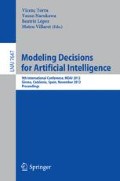Abstract
Non metric model is a kind of clustering method in which belongingness or the membership grade of each object to each cluster is calculated directly from dissimilarities between objects and cluster centers are not used.
By the way, the concept of rough set is recently focused. Conventional clustering algorithms classify a set of objects into some clusters with clear boundaries, that is, one object must belong to one cluster. However, many objects belong to more than one cluster in real world, since the boundaries of clusters overlap with each other. Fuzzy set representation of clusters makes it possible for each object to belong to more than one cluster. On the other hand, the fuzzy degree sometimes may be too descriptive for interpreting clustering results. Rough set representation could handle such cases. Clustering based on rough set representation could provide a solution that is less restrictive than conventional clustering and less descriptive than fuzzy clustering.
This paper shows two type of Rough set based Non Metric model (RNM). One algorithm is Rough set based Hard Non Metric model (RHNM) and the other is Rough set based Fuzzy Non Metric model (RFNM). In the both algorithms, clusters are represented by rough sets and each cluster consists of lower and upper approximation. Second, the proposed methods are kernelized by introducing kernel functions which are a powerful tool to analize clusters with nonlinear boundaries
Access this chapter
Tax calculation will be finalised at checkout
Purchases are for personal use only
Preview
Unable to display preview. Download preview PDF.
References
Bezdek, J.C.: Pattern Recognition with Fuzzy Objective Function Algorithms. Plenum, New York (1981)
Bezdek, J.C., Keller, J., Krisnapuram, R., Pal, N.R.: Fuzzy Models and Algorithms for Pattern Recognition and Image Processing. The Handbooks of Fuzzy Sets Series (1999)
Roubens, M.: Pattern classification problems and fuzzy sets. Fuzzy Sets and Systems 1, 239–253 (1978)
Bezdek, J.C., Davenport, J.W., Hathaway, R.J.: Clustering with the Relational c-Means Algorithms using Different Measures of Pairwise Distance. In: Juday, R.D. (ed.) Proceedings of the 1988 SPIE Technical Symposium on Optics, Electro-Optics, and Sensors, vol. 938, pp. 330–337 (1988)
Hathaway, R.J., Davenport, J.W., Bezdek, J.C.: Relational Duals of the c-Means Clustering Algorithms. Pattern Recognition 22(2), 205–212 (1989)
Endo, Y.: On Entropy Based Fuzzy Non Metric Model –Proposal, Kernelization and Pairwise Constraints. Journal of Advanced Computational Intelligence and Intelligent Informatics 16(1), 169–173 (2012)
Lingras, P., Peters, G.: Rough clustering. In: Proceedings of the 17th International Conference on Machine Learning (ICML 2000), pp. 1207–1216 (2011)
Pawlak, Z.: Rough Sets. International Journal of Computer and Information Sciences 11(5), 341–356 (1982)
Inuiguchi, M.: Generalizations of Rough Sets: From Crisp to Fuzzy Cases. In: Tsumoto, S., Słowiński, R., Komorowski, J., Grzymała-Busse, J.W. (eds.) RSCTC 2004. LNCS (LNAI), vol. 3066, pp. 26–37. Springer, Heidelberg (2004)
Pawlak, Z.: Rough Classification. International Journal of Man-Machine Studies 20, 469–483 (1984)
Hirano, S., Tsumoto, S.: An Indiscernibility-Based Clustering Method with Iterative Refinement of Equivalence Relations. Journal of Advanced Computational Intelligence and Intelligent Informatics 7(2), 169–177 (2003)
Lingras, P., West, C.: Interval Set Clustering of Web Users with Rough K-Means. Journal of Intelligent Information Systems 23(1), 5–16 (2004)
Mitra, S., Banka, H., Pedrycz, W.: Rough-Fuzzy Collaborative Clustering. IEEE Transactions on Systems Man, and Cybernetics, Part B, Cybernetics 36(5), 795–805 (2006)
Maji, P., Pal, S.K.: Rough Set Based Generalized Fuzzy C-Means Algorithm and Quantitative Indices. IEEE Transactions on System, Man and Cybernetics, Part B, Cybernetics 37(6), 1529–1540 (2007)
Peters, G.: Rough Clustering and Regression Analysis. In: Yao, J., Lingras, P., Wu, W.-Z., Szczuka, M.S., Cercone, N.J., Ślęzak, D. (eds.) RSKT 2007. LNCS (LNAI), vol. 4481, pp. 292–299. Springer, Heidelberg (2007)
Mitra, S., Barman, B.: Rough-Fuzzy Clustering: An Application to Medical Imagery. In: Wang, G., Li, T., Grzymala-Busse, J.W., Miao, D., Skowron, A., Yao, Y. (eds.) RSKT 2008. LNCS (LNAI), vol. 5009, pp. 300–307. Springer, Heidelberg (2008)
Miyamoto, S., Mukaidono, M.: Fuzzy c-Means as a Regularization and Maximum Entropy Approach. In: Proc. of the 7th International Fuzzy Systems Association World Congress (IFSA 1997), vol. 2, pp. 86–92 (1997)
Miyamoto, S., Umayahara, K., Mukaidono, M.: Fuzzy Classification Functions in the Methods of Fuzzy c-Means and Regularization by Entropy. Journal of Japan Society for Fuzzy Theory and Systems 10(3), 548–557 (1998)
Vapnik, V.N.: Statistical Learning Theory. Wiley, New York (1998)
Vapnik, V.N.: The nature of Statistical Learning Theory, 2nd edn. Springer, New York (2000)
Endo, Y., Haruyama, H., Okubo, T.: On Some Hierarchical Clustering Algorithms Using Kernel Functions. In: IEEE International Conference on Fuzzy Systems, #1106 (2004)
Hathaway, R.J., Huband, J.M., Bezdek, J.C.: A Kernelized Non-Euclidean Relational Fuzzy c-Means Algorithm. Neural, Parallel and Scientific Computation 13, 305–326 (2005)
Miyamoto, S., Kawasaki, Y., Sawazaki, K.: An Explicit Mapping for Fuzzy c-Means Using Kernel Function and Application to Text Analysis. In: IFSA/EUSFLAT 2009 (2009)
Mercer, J.: Functions of Positive and Negative Type and Their Connection with the Theory of Integral Equations. Philosophical Transactions of the Royal Society A 209, 415–446 (1909)
Author information
Authors and Affiliations
Editor information
Editors and Affiliations
Rights and permissions
Copyright information
© 2012 Springer-Verlag Berlin Heidelberg
About this paper
Cite this paper
Endo, Y., Heki, A., Hamasuna, Y. (2012). On Rough Set Based Non Metric Model. In: Torra, V., Narukawa, Y., López, B., Villaret, M. (eds) Modeling Decisions for Artificial Intelligence. MDAI 2012. Lecture Notes in Computer Science(), vol 7647. Springer, Berlin, Heidelberg. https://doi.org/10.1007/978-3-642-34620-0_35
Download citation
DOI: https://doi.org/10.1007/978-3-642-34620-0_35
Publisher Name: Springer, Berlin, Heidelberg
Print ISBN: 978-3-642-34619-4
Online ISBN: 978-3-642-34620-0
eBook Packages: Computer ScienceComputer Science (R0)

